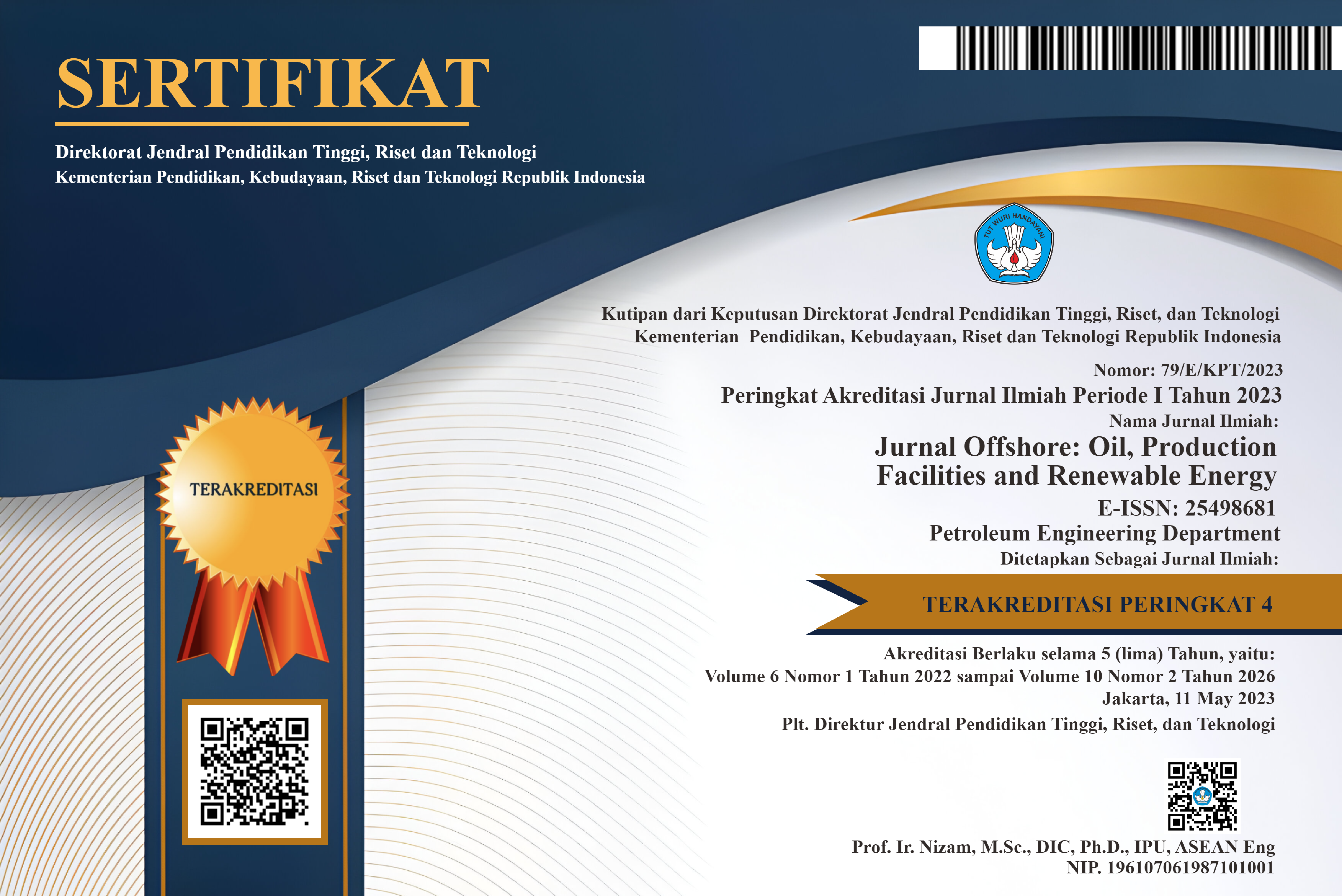Proses Konversi Metana Menjadi Hidrogen dengan Proses Pirolisis dalam Reaktor Kolom Gelembung Menggunakan Logam Cair
DOI:
https://doi.org/10.30588/jo.v7i1.1738Abstract
Proses pirolisis metana yang menghasilkan hidrogen tanpa melepaskan emisi CO2, sangat menjanjikan karena juga memproduksi hasil samping berupa karbon yang bermutu tinggi. Penggunaan logam cair sebagai media reaksi mampu memperbaiki proses konversi dan mengatasi masalah pengerakan pada reaktor kolom gelembung. Untuk mengetahui pengaruh suhu dan laju aliran gas terhadap konversi metana di dalam reaktor, dilakukan studi eksperimental di laboratorium. Hasil penelitian menunjukkan bahwa konversi gas metana meningkat ketika temperatur reaktor dan laju aliran gas menurun. Proses konversi gas metana tertinggi didapatkan pada suhu reaksi 1000°C dan laju aliran gas 50 ml/menit, yaitu sebesar 54,46%.References
Ashik, W. W. Daud and H. F. Abbas (2015). Production of greenhouse gas free hydrogen by thermocatalytic decomposition of methane – A review. Renewable and Sustainable Energy Reviews, vol. 44, pp. 221-256.
Kothari, R.; Buddhi, D.; Sawhney, R.L. (2008). Comparison of environmental and economic aspects of various hydrogen production methods. Renew. Sustain. Energy Rev. 2008, 12, 553–563.
Dawood, M. Anda and G. M. Shafiullah (2020). Hydrogen production. Hydrogen Energy, vol. 45, no. 7, p. 3847−3869.
Kang, D., Clarke Palmer, Davide Mannini, Nazanin Rahimi, Michael J. Gordon, Horia Metiu, and Eric W. McFarland (2020). Catalytic Methane Pyrolysis in Molten Alkali Chloride Salts Containing Iron. ACS Catalysis, 10, 7032−7042
Dagle, V. Dagle, M. D. Bearden, J. Holladay, T. R. Krause and S. Ahmed (2017). An Overview of Natural Gas Conversion Technologies for Co-Production of Hydrogen and Value-Added Solid Carbon Products. Pacific Northwest National Lab: Richland, USA.
Bastardo, R. Schlo¨ gl and H. Ruland (2020). Methane Pyrolysis for CO2-Free H2 Production: A Green Process to Overcome Renewable Energies Unsteadiness. Chemie Ingenieur Technik, vol. 92, no. 10, pp. 1596-1609.
Msheik, R. Sylvain and A. Stéphane (2021). Methane Cracking for Hydrogen Production: A Review of Catalytic and Molten Media Pyrolysis. Energies, vol. 14, p. 3107.
Kopp, M.; Coleman, D.; Stiller, C.; Scheffer, K.; Aichinger, J.; Scheppat, B. (2017). Energiepark Mainz : Technical and economic analysis of the worldwide largest Power-to-Gas plant with PEM electrolysis. Int. J. Hydrog. Energy, 42, 13311–13320.
Abánades, A.; Rubbia, C.; Salmieri, D. (2013). Thermal cracking of methane into Hydrogen for a CO2-free utilization of natural gas. Int. J. Hydrog. Energy, 38, 8491–8496.
Tyrer, D. (1931). Production of Hydrogen. U.S. Patent 1,803,221, 28 April 1931.
Steinberg, M. (1999). Fossil fuel decarbonization technology for mitigating global warming. Int. J. Hydrog. Energy, 24, 771–777.
Schultz, I.; Agar, D.W. (2015). Decarbonisation of fossil energy via methane pyrolysis using two reactor concepts: Fluid wall flow reactor and molten metal capillary reactor. Int. J. Hydrog. Energy, 40, 11422–11427.
Serban Manuela, Lewis Michele A, Marshall Christopher L, Doctor Richard D. (2003). Hydrogen production by direct contact pyrolysis of natural gas. Energy & Fuels. 17(3):705e13.
Muradov Nazim, Smith Franklyn, T-Raissi Ali. (2005). Catalytic activity of carbons for methane decomposition reaction. Catal Today 2005;102e103:225e33. 1st International Symposium on Carbon for Catalysis
Paxman D, Trottier S, Nikoo M, Secanell M, Ordorica-Garcia G. (2014). Initial experimental and theoretical investigation of solar molten media methane cracking for hydrogen production. Energy Procedi., 49(0):2027e36. Proceedings of the SolarPACES 2013 International Conference.
Plevan M, Stoppel L, Wetzel Th, Heinzel A, Weisenburger A, Muller. (2013). Hydrogen production via direct thermal cracking of methane: concept of a molten metal bubble column reactor. In: Proc. of 5th World Hydrogen Technologies Convention (WHTC2013), 5; 2013. p. 111.
Geißler, M. Plevan, A. Abánades, A. Heinzel, K. Mehravaran, R.K. Rathnam, C. Rubbia, D. Salmieri, L. Stoppel, S. Stückrad, A. Weisenburger, H. Wenninger, and Th. Wetzel. (2019). Experimental investigation and thermo-chemical modeling of methane pyrolysis in a liquid metal bubble column reactor with a packed bed. International Journal of Hydrogen Energy, 40(41):14134 – 141.
Geiger, C.A. Busse, and R.I. Loehrke. (2015). The vapor pressure of indium, silver, gallium, copper, tin, and gold between 0.1 and 3.0 bar. International Journal of Thermophysics, 8 (4) : 425 – 436.
Bastardo,, R. Schlögl and Ruland. (2021). Methane Pyrolysis for Zero-Emission Hydrogen Production: A Potential Bridge Technology from Fossil Fuels to a Renewable and Sustainable Hydrogen Economy. Industrial & Engineering Chemistry Research, vol. 60, no. 32, pp. 11855-11881.
Rastegarpanah, F. Meshkani and M. Rezaei. (2017). COx-free hydrogen and carbon nanofibers production by thermocatalytic decomposition of methane over mesoporous MgO•Al2O3 nanopowder supported nickel catalysts. Fuel Processing Technology, vol. 167, p. 250−262.
Zhang, X.; Kätelhön, A.; Sorda, G.; Helmin, M.; Rose, M.; Bardow, A.; Madlener, R.; Palkovits
, R.; Mitsos. (2018). A. CO2 Mitigation Costs of Catalytic Methane Decomposition. Energy, 151, 826−838.
Downloads
Published
How to Cite
Issue
Section
License
Authors retain copyright and grant the Jurnal Offshore right of first publication with the work simultaneously licensed under a Creative Commons Attribution 4.0 International License that allows others to share (copy and redistribute the material in any medium or format) and adapt (remix, transform, and build upon the material) the work for any purpose, even commercially with an acknowledgement of the work's authorship and initial publication in Jurnal Offshore. Authors are able to enter into separate, additional contractual arrangements for the non-exclusive distribution of the journal's published version of the work (e.g., post it to an institutional repository or publish it in a book), with an acknowledgement of its initial publication in Jurnal Offshore. Authors are permitted and encouraged to post their work online (e.g., in institutional repositories or on their website) prior to and during the submission process, as it can lead to productive exchanges, as well as earlier and greater citation of published work (See The Effect of Open Access).















